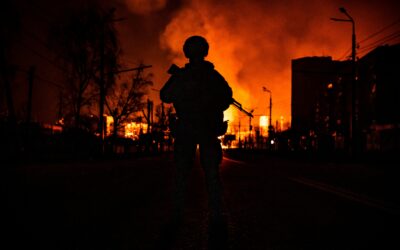
In Future Wars, Drone Weapons With Minds of Their Own
SUBSCRIBER+EXCLUSIVE BRIEFING — Drone weapons are part of the daily narrative of the war in Ukraine – from Russia’s use of Iranian drones against infrastructure […] More
Javed Ali is a Towsley Policymaker in Residence at the University of Michigan’s Gerald R. Ford School of Public Policy and had over 20 years professional experience in Washington, DC on national security issues, to include senior roles at the Federal Bureau of Investigation, Office of the Director of National Intelligence, and National Security Council.
As the country continues to grasp the enormity and significance of the violent siege against the US Capitol on 6 January, one of the most unresolved issues is what drove thousands of Americans to ransack an iconic landmark, attack law enforcement officers, and possibly look to kidnap or take hostage, the Vice President or members of Congress and their staff. As someone who spent several years in government looking at how and why individuals are drawn to different violent extremist agendas, the ideological diversity of Americans operating in the “extreme-right” seems different than when looking at Americans inspired to similar violence by either al-Qa’ida or the Islamic State in Iraq and Syria (ISIS).
A US government-sponsored research project published in 2016 on the topic of “jihadist”-inspired terrorism from al-Qa’ida, ISIS, and related groups indicated that one of the key behaviors that effected individuals along the way from radicalization to mobilization was increased religious fervor. The same study, however, noted that radicalization was a long and deliberate process that did not happen rapidly, and could be shaped by several events that affected those examined in the project. In their words, “there was no profile of a jihadist terrorist.”
A separate effort, led by analysts at George Washington University released in 2018, examined Americans who attempted to travel to the Middle East to join jihadist groups, to include ISIS. Like the 2016 report, it too stated “there was no single profile of an American traveler” but found that several factors including religion combined to propel individuals in the United States to make the decision to travel, with some based on a desire to engage in violent action overseas. As a result, when looking at either US-based jihadist extremists looking to commit violence here, or those born and raised here but sought to take the fight overseas, there is data to suggest a twisted interpretation of Islam was key element for those who wished to act out.
Based on what we know about the individuals associated with violent action at the US Capitol who have been publicly identified and either arrested or under investigation by the FBI, we see some interesting trends emerging. Religion does not yet appear to be the overriding driver for violence at the Capitol—unlike in the jihadist arena— and several individuals wrapped themselves around the notion of a hyper-aggressive form of patriotism that in their mind, justified violence that day. As with American jihadists who believed that their interpretation of Islam condoned violence against their perceived enemies, so too did dozens of Americans who believed that it was their patriotic duty to unseat members of Congress and restore a more just and representative form of government through violent action. Not since the American Revolution against British rule have citizens in this country risen up to take up arms against a perceived tyrannical government, and some media reports have already cited the extensive use of Revolutionary War-era symbols, images and rhetoric expressed by individuals at the Capitol siege.
However, in addition to the notion of an extreme patriotism connected to the struggle of the Colonial era in the United States, a broader range of ideas and narratives were expressed by those participating in violence at the Capitol. Individuals holding neo-Nazi, white-supremacist, QAnon, anti-government, and other fringe or esoteric beliefs, also engaged in the siege, showing the diversity of views within this broad movement in the United States that defies a single description or characterization when contrasted with the jihadist camp. As a result, “extreme-right” may be a useful phrase to help distinguish this threat since no one single label seems to fit neatly.
Beyond the notion of what to call this threat, the harder challenge for law enforcement and other elements of the US national security enterprise is what to do about it. According to media reports, U.S. government threat bulletins have warned of future violence from individuals operating under this broad extreme-right banner to the Inauguration and associated events next week. In response, federal, state and local resources are being mobilized to provide enhanced physical security throughout the country, but it is unclear how long personnel operate in these elevated conditions— and unlike Europe, there is no modern equivalent to the large-scale deployment of military forces in large cities for weeks and months at a time in the face of internal terrorist threats. Once past the Inauguration, however, will come the really hard part.
The United States faces a serious internal security threat posed by the prospect of additional violence from its own citizens who believe their government no longer represents them, that the November 2020 election results are illegitimate, that their individual liberties and privacy has been trampled upon, or that the social fabric of the country no longer resembles that from which they or previous generations remember. Decoding the beliefs and mindsets that animate violence against fellow citizens will be one of the key security challenges for the incoming Biden Administration, and should spur a new paradigm for domestic counterterrorism.
Read more expert-driven national security news, perspective and analysis in The Cipher Brief
Related Articles

SUBSCRIBER+EXCLUSIVE BRIEFING — Drone weapons are part of the daily narrative of the war in Ukraine – from Russia’s use of Iranian drones against infrastructure […] More

SUBSCRIBER+ EXCLUSIVE ANALYSIS — Iran’s retaliatory strikes against Israel this weekend were both a potentially game-changing, historic first — and an underwhelming response. Historic, because […] More

SUBSCRIBER+EXCLUSIVE INTERVIEW — Ukraine was hit by a fresh round of Russian missile attacks on Thursday, strikes that targeted and damaged the country’s power grid […] More

SUBSCRIBER+ EXCLUSIVE REPORTING — The Israeli drone strike that killed three adult sons (who Israel says were Hamas operatives) and four grandchildren of Hamas’s Qatar-based […] More

BOTTOM LINE UP FRONT – In the spring of 2022, Ukraine beat back a Russian assault on the nation’s capital and punished the invaders on […] More

SUBSCRIBER+EXCLUSIVE — The Ukraine war has reached a “pivotal moment,” a “critical stage,” an “inflection point“ – all phrases used to describe the current situation […] More
Search